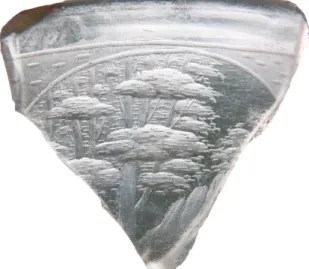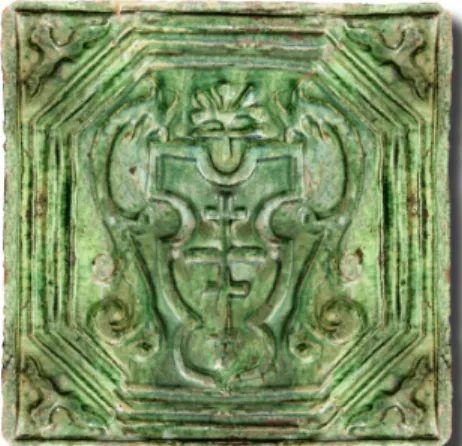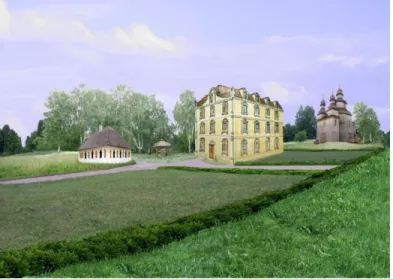Canadio-Byzantina 23 (January 2012)
16REPORTS
Excavations at Baturyn in 2011
During the summer of 2011 the Canada-Ukraine archaeological expedition resumed its annual excavations in Baturyn, Chernihiv province, Ukraine. The Canadian Institute of Ukrainian Studies (CIUS), the Pontifical Institute of Mediaeval Studies (PIMS) in Toronto, and the Shevchenko Scientific Society of America (SSS-A) co-sponsor the project. Prof. Zenon Kohut, Director of CIUS, heads this undertaking; Prof. Orest Popovych, President of SSS-A, is its patron and academic adviser; Dr. Volodymyr Kovalenko, University of Chernihiv, leads the expedition. Dr. Volodymyr Mezentsev (CIUS), Prof. Martin Dimnik (PIMS), and Huseyin Oylupinar, Ph.D.candidate (University of Alberta), are also engaged in the excavation and the publication of its findings. The 2011 expedition recruited 75 students and scholars from the universities and museums of Chernihiv, Nizhyn, Kyiv, Sumy, Baturyn, Hlukhiv, Melitopol, Chernivtsi in Ukraine, and Toronto and Edmonton in Canada.
From 1669 to 1708, Baturyn was the capital of the Cossack Hetman state that reached its zenith under the rule of the enlightened Hetman Ivan Mazepa (1687-1709). In alliance with Sweden he attempted to liberate central Ukraine from increasing Moscow domination but the Russian army suppressed his insurrection and destroyed Baturyn in 1708.
This year’s expedition continued excavating the remnants of Mazepa’s fortified court located in the Baturyn suburb of Honcharivka. Around 1699 he commissioned the erection of the three-story masonry palace; it was unrivalled in the Cossack realm and became his principal residence. Archaeological and architectural investigations of the palace’s remnants in 2003-10 have established that it was built and adorned in a mature Vilnius (Wilno) Baroque style and enriched with the ornate polychrome glazed ceramic revetments of the Kyivan Baroque style. Tsarist troops burned Mazepa’s
residence in 1708.
In 2011 archaeologists discovered fragments of costly imported tableware near the palace site. This included a broken 17th-century cut-glass wine goblet that was probably produced in Habsburg Silesia. It was decorated with an artistic delicately engraved landscape executed in the in cameo technique. The depiction of the trees was modelled on early modern Chinese landscape paintings. Moreover, several fragments of thin grey-clay pottery covered with brown glaze constituted part of the German exports to Eastern Europe in the 17th-18th centuries. Broken painted porcelain plates also represent either Western exports to Baturyn or early-modern Russian imitations of fashionable china dishes. These finds attest to the wealth and refined tastes at the hetman’s court as well as the vibrancy of Baturyn’s commercial and cultural contacts with Western Europe during the Mazepa era.
Figure 8: Fragment of a 17th-century
glass wine goblet with engraved
landscape discovered at the hetman
residence in Honcharivka in 2011. All
photos by V. Mezentsev
Canadio-Byzantina 23 (January 2012)
17 West of the palace the team unearthed the remnants of a number of either dwellings or service structures; one of these was seemingly a timber kitchen with large baked-clay ovens. The heating stoves of these buildings were ornamented with fine ceramic tiles covered mainly by a green glaze. They featured relief plant patterns in the Baroque style and a coat of arms. The fragmented heraldic tile has been reconstructed by a computer graphic technique at the University of Toronto. It displays an unusual Orthodox relief cross with four cross-arms on a figured Renaissance shield framed by two garlands and four stylized angels, or putti, in the tile’s corners. These heraldic symbols have been identified as an early version of Mazepa’s armorial emblem, which derived from the Polish coat of arms known as Boycza. These stove tiles, similar to the decorative ceramic details of the hetman’s palace, were likely fashioned by the more skilled Kyivan artisans rather than by local Baturyn craftsmen.Written sources indicate that around 1699 Mazepa also endowed the wooden Resurrection Church at his Honcharivka villa. After its remnants were partially uncovered north of the palace in 2011 preliminary observations suggested that the edifice was at least 8 m. by 5 m. in size. Next summer the investigators will complete excavating the church and determine its ground plan and, it is hoped, its structural design and adornments.
Fragments of a copper cup or chalice and of a terracotta slab (15 x 10 x 5.2 cm.), with a Cyrillic inscription and the relief of a flower, were found on the site. Although only three words from the text have been preserved, it clearly acknowledges Mazepa as the founder of the church and provides its date. An analogous ceramic plaque with a full similar inscription, relief garlands with flowers and leaves, and Mazepa’s armorial bearings was attached to the belfry (1700-02) of the Monastery of SS Borys and Hlib in Chernihiv. Owing to its inscription, the slab discovered at Honcharivka is considered to be a rare archaeological find and a valuable new historical source for Baturyn studies. Other artefacts unearthed at Mazepa’s household were the following: a 17th-18th–century billon coin minted in Swedish Livonia, four silver and copper Polish-Lithuanian coins, one Russian copper coin, eight terracotta and glazed ceramic ornamented Cossack tobacco pipes and painted earthenware manufactured locally in a distinctive vernacular style. Six lead musket bullets and an exploding iron cannon ball or grenade, relics of the 1708 attack on Baturyn, were also found.
Figure 9: Heraldic glazed
ceramic stove tile found at
Mazepa's court in
Honcharivka. Computer
reconstruction by W.
Sydorenko, 2011
Figure 10: Fragment of
terracotta slab with
inscription and relief of a
flower from the court
church of Mazepa. 2011
excavations in
Canadio-Byzantina 23 (January 2012)
18On the basis of their historical and archaeological explorations of hetman’s palatial residence in Honcharivka researchers have prepared a hypothetical computer reconstruction of this unique architectural complex. The annual excavations in Baturyn are scheduled to resume in the summer of 2012.
Martin Dimnik and Volodymyr Mezentsev
The 22 International Congress of Byzantine Studies, Sofia, 22-27 August 2011nd
(reprinted, with permission, from the Newsletter of the SPBS)
Since the programme of the conference can still be found on the web, it does not seem worthwhile to offer a blow-by-blow account of the many and varied sessions that took place through the week. Instead I shall offer a few impressions of the congress. The papers took place in the buildings of the university St Kliment Ohridski close to the city centre, within easy reach of many, if not all, hotels. The university rooms varied greatly in quality: some had recently been refurbished, others featured benches that might easily deposit the unwary on the floor, and others again were far too small for the sessions that had been scheduled there. The opening ceremony was packed; many had to stand. Throughout the conference the weather was hot and sunny, with the result that some rooms grew unbearably warm in the afternoon.
T
frhoemre E wasetreer nso Emuero opnee; tbhyo nuosa mnde apneso apllle tihno asett efenadtaunrceed, imn athney programme were present, as became clear when it became necessary for others to read out their papers. While the mornings were reserved for plenary sessions, the afternoons featured parallel sessions, with similar topics being grouped together each afternoon. This was frustrating, since it meant a large number of clashes, which could have been avoided. Nevertheless, the papers gave a good opportunity to meet fellow scholars, to make contacts, and of course to hear useful contributions on a wide range of topics. There were a number of exhibitions and receptions organised during the week, the highlight of which was the event at the National Museum of History, the former presidential palace, at which the current president addressed the assembled Byzantinists.


